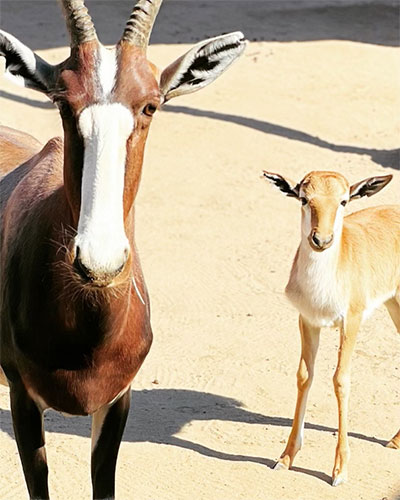
One of my exhibits housed a handful of African antelopes called Bontebok. We had recently received a new herd sire and he was now sharing this space with his new herd. Although the females were used to me and our routines, this new male was not. It was clear from his behavior that he did not appreciate me entering his new territory and engaging his new girls. There was plenty of room to safely allow his assertive posturing at a distance, but it was clear he didn’t want me coming any closer and I knew he could be dangerous.
Recognizing both the necessity of the task at hand and the potential risk posed by this new male, I considered my options from a training perspective. How could I still effectively check on my charges while honoring his new role in the herd and reducing my risk of confrontation or injury? I decided I would make him a deal.
I took a seat on a large boulder at the back of the exhibit, far enough away to not crowd him. I got quiet and tuned in to him, mentally telling him how handsome he was and how well he was protecting his new ladies. Next, I acknowledged that I understood he did not know why I was there and that he considered me a threat. I then explained my role as caretaker, and that I needed to check on them every morning to be sure that nobody needed any medical help. I told him that by seeing each of them walking soundly, I would know they were alright and could leave them to their morning.
Here’s where the training came in. I knew that the behavior I chose to reinforce would get stronger with repetition. I also knew that, in his case, the most valuable form of reinforcement would likely be my absence. With this in mind, I offered him my deal. I promised to stay back at this boulder and not encroach further if he did my job for me. I politely asked him to get each of the five girls up from their rest and make them take a few steps. Once the last girl was up and moving, I would thank him by leaving. It was as simple as that. He’d get his way and I would get mine.
To my utter amazement, he took that deal, and we began an ongoing arrangement of mutual respect. Every morning, I would enter the yard and sit on my rock. We would acknowledge each other, then I would visualize which girl he should rouse first, and each subsequent girl after that until he had succeeded in getting them all up and moving. I set us both up for success by choosing the ladies who were closest to him first, and I didn’t rush him, allowing each of them to stretch and ease into the activity without any emotional pressure from me. It was remarkably smooth and amicable, and as promised, I promptly left after the last girl was up. This became our new morning-check routine.
This experience was a huge lesson by illustrating how well animal training and animal communication could compliment each other when addressing a behavioral challenge. My training background helped me read his behavior and devise a plan to reduce his potential aggression, while my animal communication allowed me to clearly explain this plan to him and show him what he’d have to gain by participating. Most importantly, it shifted my attitude toward him from seeing him as a potential problem to a respected partner. I am so grateful he was willing to work with me! I still shake my head and smile everytime I think of it.
